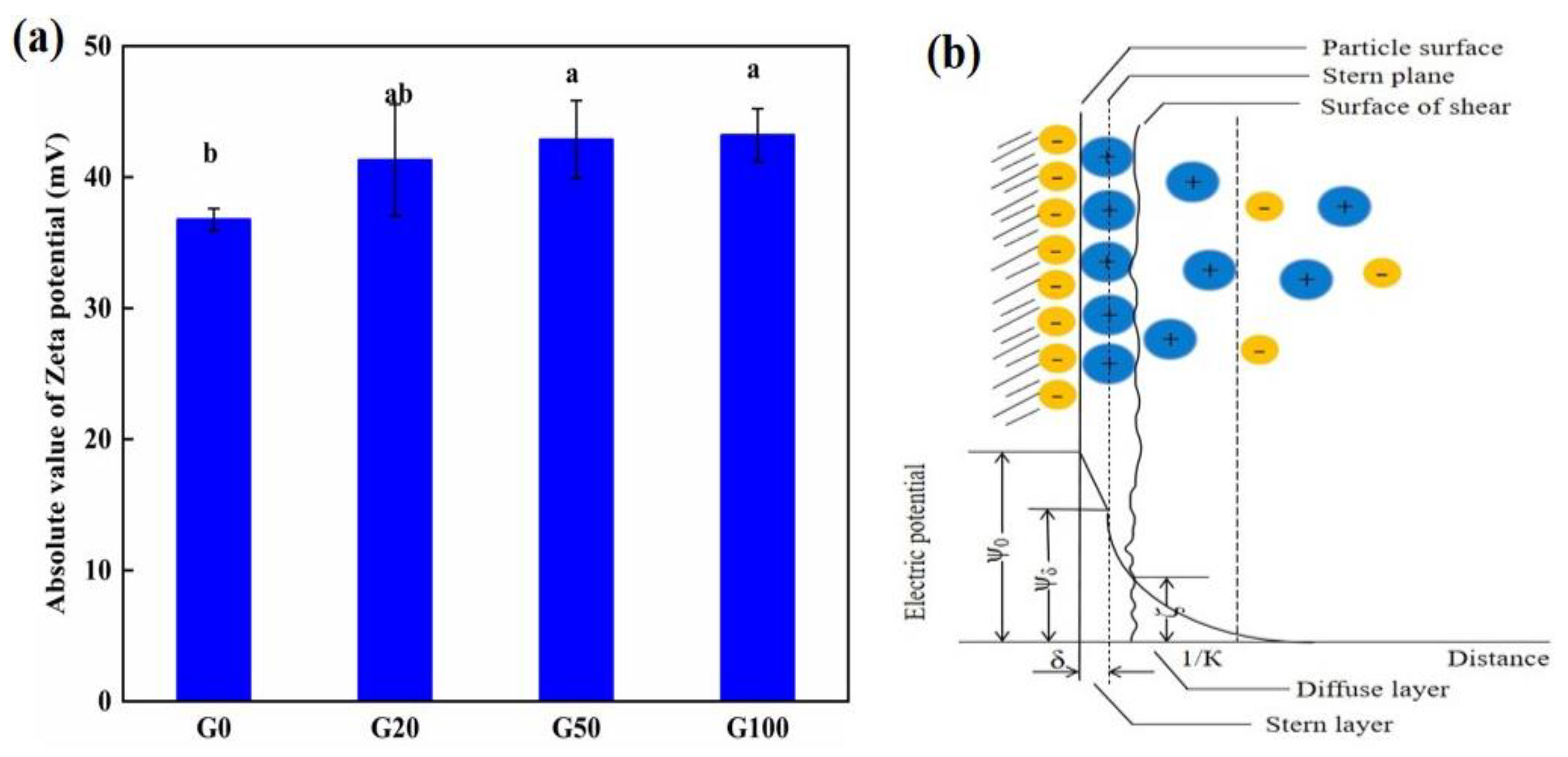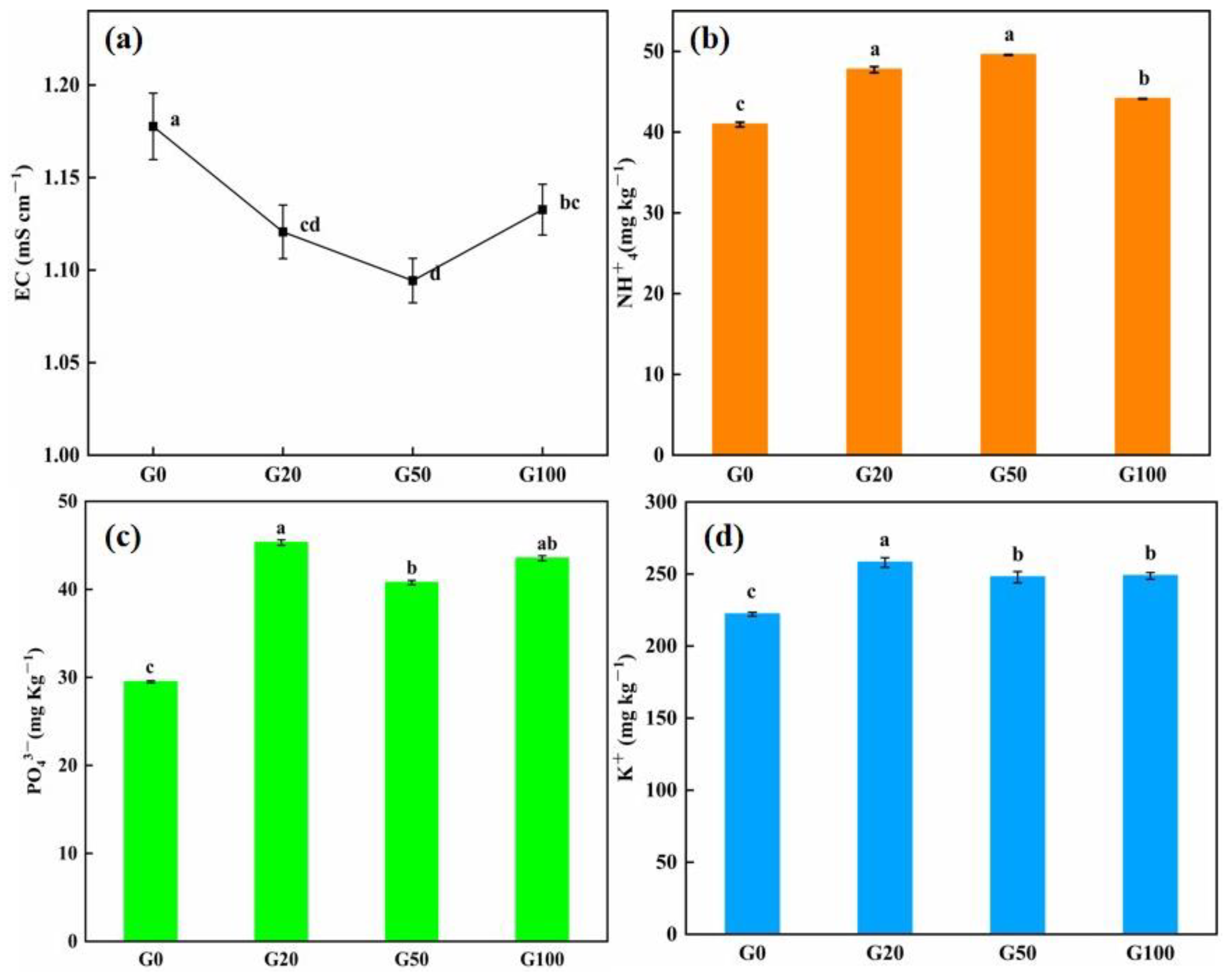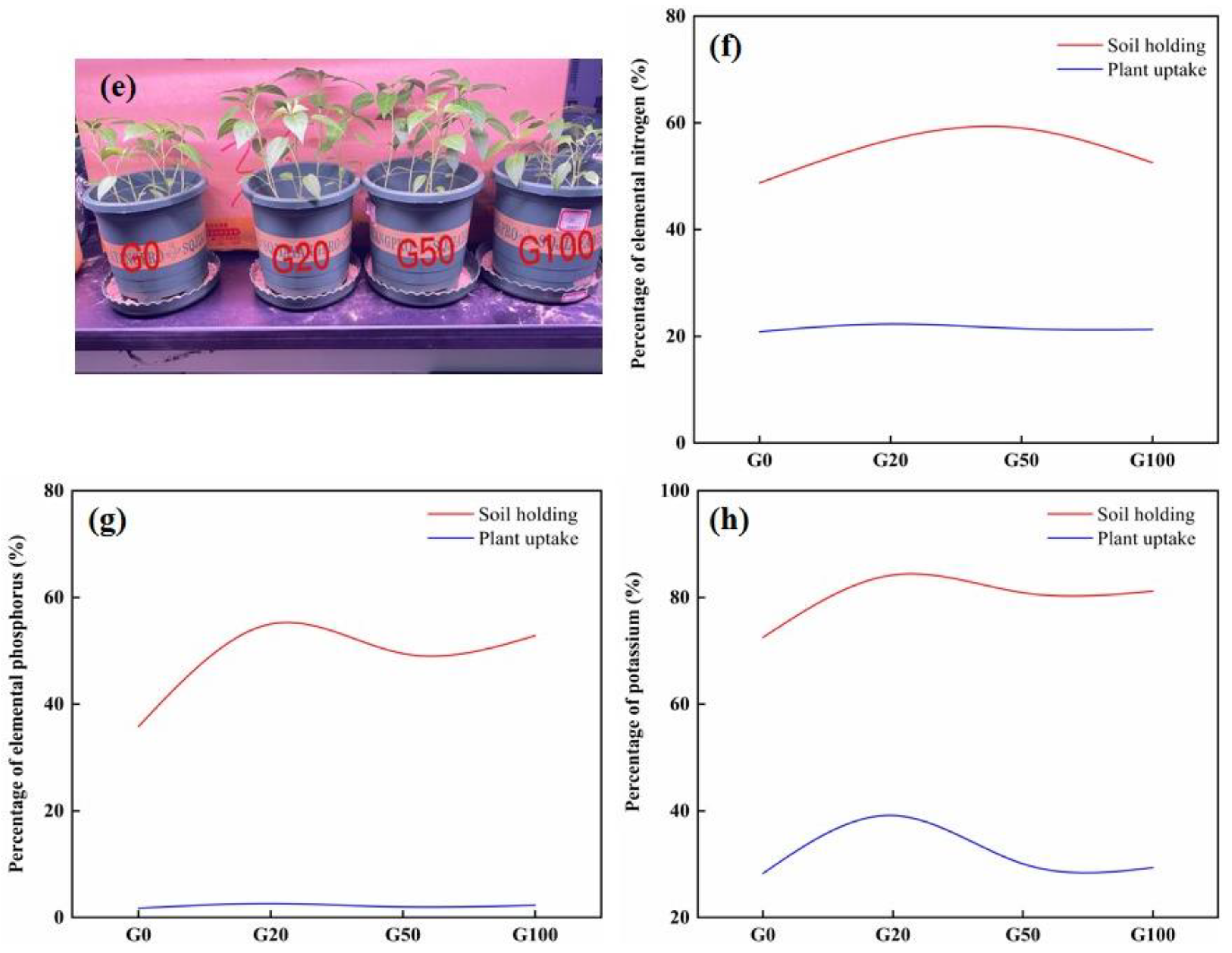Fertilizer-Holding Performance of Graphene on Soil Colloids Based on Double Electric Layer Theory
Abstract
1. Introduction
2. Materials and Methods
2.1. Materials and Instruments
2.2. Test Method
2.2.1. Soil Colloid Zeta Potential Measurement
2.2.2. Leaching Test
2.2.3. Soil Agglomerate Stability Measurement
2.2.4. Pepper Seedling Cultivation
2.2.5. Nutrient Test Method
2.3. Statistical Analysis
3. Results and Discussion
3.1. Effect of Graphene on Soil after Leaching
3.1.1. Effect of Graphene on Ion Concentration
3.1.2. Effect of Graphene on Soil Nutrient Retention after Leaching
3.1.3. Effect of Graphene on the Stability of Soil Microagglomerates
3.2. Effect of Graphene on Plant Growth
4. Conclusions
- (1)
- The addition of graphene to soil colloids increased the zeta potential of the colloids, which increased with an increase in graphene concentration. According to the Derjaguin–Landau–Verway–Overbeek theory, and what we understand about double electric layers, when only graphene is added to soil without increasing the fertilizer, the zeta potential of soil colloids increases. This represents the increase in ion concentration, indicating that graphene can increase the ion concentration of soil colloids.
- (2)
- After rainwater drenching and soaking, soil with added graphene could effectively reduce the loss of ammonium nitrogen, effective phosphorus, and fast-acting potassium. In terms of soil structure, graphene improved the stability and erosion resistance of soil microaggregates and improved soil fertility retention.
- (3)
- When graphene was applied to soil alongside fertilizer, plant growth was promoted. This was especially true when the graphene concentration was 20 mg/L, in which the plant height, root length, and nutrient absorption of pepper seedlings were most significant. In summary, our findings show that graphene can effectively reduce nutrient loss and promote plant nutrient uptake.
- (4)
- As a new type of soil conditioner and fertilizer additive, graphene has a strong adsorption effect on nutrient ions owing to its large specific surface area. This can reduce the loss of nutrients from the soil through rainfall leaching. At the same time, graphene can improve the utilization rate of nutrients by reducing their loss, which is conducive to plant absorption and growth promotion.
Author Contributions
Funding
Institutional Review Board Statement
Informed Consent Statement
Data Availability Statement
Acknowledgments
Conflicts of Interest
References
- Schmickler, W. Electrochemical Theory: Double Layer. Reference Module in Chemistry, Molecular Sciences and Chemical Engineering; Elsevier: Amsterdam, The Netherlands, 2014; pp. 1–10. [Google Scholar]
- Xinrong, T. Surface Physical Chemistry; Chemical Industry Press: Beijing, China, 2009; pp. 154–160. [Google Scholar]
- Zhongping, W.; Zhenping, S.; Ming, J. Surface Physical Chemistry; Tongji University Press: Shanghai, China, 2015; pp. 240–247. [Google Scholar]
- Belhachemi, F.; Rael, S.; Davat, B. A physical based model of power electric double-layer supercapacitors. In Proceedings of the Conference Record of the 2000 IEEE Industry Applications Conference. Thirty-Fifth IAS Annual Meeting and World Conference on Industrial Applications of Electrical Energy (Cat. No. 00CH37129), Rome, Italy, 8–12 October 2000; IEEE Publications: Piscataway, NJ, USA, 2000; Volume 5, pp. 3069–3076. [Google Scholar]
- Somers, S.A.; Davis, H.T. Microscopic dynamics of fluids confined between smooth and atomically structured solid surfaces. J. Chem. Phys. 1992, 96, 5389–5407. [Google Scholar] [CrossRef]
- Wang, Y.-Z.; Shan, X.-Y.; Ma, L.-P.; Wang, J.W.; Wang, D.-W.; Peng, Z.Q.; Cheng, H.-M.; Li, F. A desolvated solid-solid interface for a high-capacitance electric double layer. Adv. Energy Mater. 2019, 9, 1803715. [Google Scholar] [CrossRef]
- Cheng, C. The Bilayer Structure of Soil Colloids and Its Influencing Factors; Nanjing Agricultural University: Nanjing, China, 2009. [Google Scholar]
- Cheng, F.; Guo, S.; Li, G.; Wang, S.; Li, F.; Wu, B. The loss of mobile ions and the aggregation of soil colloid: Results of the electrokinetic effect and the cause of process termination. Electrochim. Acta. 2017, 258, 1016–1024. [Google Scholar] [CrossRef]
- Hiemenz, P.C. The electrical double layer. In Principles of Colloid and Surface Chemistry, 2nd ed.; Marcel Dekker Inc.: New York, NY, USA; Basel, Switzerland, 1986; Chapter 12; pp. 677–729. [Google Scholar]
- Xiao, J.; Wen, Y.; Xianhong, M. Theoretical deduction and application of unfrozen water content in frozen soil based on electric double layer model. Geomechanics 2019, 40, 1449–1456. [Google Scholar]
- Zhang, L.; Yang, C.; Wang, D.; Zhang, P.; Zhang, Y. Freezing point depression of soil water depending on its non-uniform nature in pore water pressure. Geoderma 2022, 412, 115724. [Google Scholar] [CrossRef]
- Zhang, L.; Zhuang, Q.; Wen, Z.; Zhang, P.; Ma, W.; Wu, Q.; Yun, H. Spatial state distribution and phase transition of non-uniform water in soils: Implications for engineering and environmental sciences. Adv. Colloid Interface Sci. 2021, 294, 102465. [Google Scholar] [CrossRef]
- Jin, X.; Yang, W.; Gao, X.; Zhao, J.; Li, Z.; Jiang, J. Modeling the unfrozen water content of frozen soil based on the absorption effects of clay surfaces. Water Resour. Res. 2020, 56, e2020. [Google Scholar] [CrossRef]
- Moayedi, H.; Kazemian, S.; Kassim, K.A.; Nazir, R.; Raftari, M. Removal of suspended colloids through the control of their zeta potential. J. Dispers. Sci. Technol. 2013, 34, 1273–1279. [Google Scholar] [CrossRef]
- Zou, X.; Xu, J.; Zhao, A.; Ji, G. Desorption of copper ions adsorbed by variable charge soils. Acta Pedol. Sin. 2004, 41, 68–73. [Google Scholar] [CrossRef]
- Tianren, Y.; Guoliang, J.; Changpu, D. Electrochemistry of Variable-Charge Soils; Science Press: Beijing, China, 1996; pp. 135–139. [Google Scholar]
- Tripathy, S.; Sridharan, A.; Schanz, T. Swelling pressures of compacted bentonites from diffuse double layer theory. Can. Geotech. J. 2004, 41, 437–450. [Google Scholar] [CrossRef]
- Sparks, D.L. Soil physical chemistry. Soil Sci. 1988, 145, 231–232. [Google Scholar] [CrossRef]
- Novoselov, K.S.; Geim, A.K.; Morozov, S.V.; Jiang, D.; Zhang, Y.; Dubonos, S.V.; Grigorieva, I.V.; Firsov, A.A. Electric field effect in atomically thin carbon films. Science 2004, 306, 666–669. [Google Scholar] [CrossRef]
- Qiqi, S.; Chenxu, J.; Jun, Q.; Jianguo, Z.; Haiyan, W.; Jingwei, L.; Baoyan, X. Effect of combine application of graphene solution and fertilizer on soil nutrient loss. J. Soil Water Conserv. 2019, 33, 39–44. [Google Scholar]
- Pandorf, M.; Pourzahedi, L.; Gilbertson, L.; Lowry, G.V.; Herckes, P.; Westerhoff, P. Graphite nanoparticle addition to fertilizers reduces nitrate leaching in growth of lettuce (Lactuca sativa). Environ. Sci. Nano 2020, 7, 127–138. [Google Scholar] [CrossRef]
- Barreto, R.C.; Madari, B.E.; Maddock, J.E.L.; Machado, P.L.O.A.; Torres, E.; Franchini, J.; Costa, A.R. The impact of soil management on aggregation, carbon stabilization and carbon loss as CO2, in the surface layer of a rhodic ferralsol in Southern Brazil. Agric. Ecosyst. Environ. 2009, 132, 243–251. [Google Scholar] [CrossRef]
- Norman, H.A.; Thompson, G.A. Quantitative analysis of Dunaliella salina diacylglyceryltrimethylhomoserine and its individual molecular species by high performance liquid chromatography. Plant Sci. 1985, 42, 83–87. [Google Scholar] [CrossRef]
- Walton, R.S.; Volker, R.E.; Bristow, K.L.; Smettem, K.R.J. Experimental examination of solute transport by surface runoff from low-angles slopes. J. Hydrol. 2000, 233, 19–36. [Google Scholar] [CrossRef]
- Hunter, R.J. Zeta Potential in Colloid Science-Principles and Applications; Academic Press: London, UK, 1981. [Google Scholar]
- Yu, T.R. Chemistry of Variable Charge Soils; Oxford University Press: New York, NY, USA, 1997. [Google Scholar]
- Al Mahrouqi, D.; Vinogradov, J.; Jackson, M.D. Zeta potential of artificial and natural calcite in aqueous solution. Adv. Colloid Interface Sci. 2017, 240, 60–76. [Google Scholar] [CrossRef]
- Zhao, G.; Zhu, H. Cation-π interactions in graphene-containing systems for water treatment and beyond. Adv. Mater. 2020, 32, e1905756. [Google Scholar] [CrossRef] [PubMed]
- Schottel, B.L.; Chifotides, H.T.; Dunbar, K.R. Anion-π interactions. Chem. Soc. Rev. 2008, 37, 68–83. [Google Scholar] [CrossRef]
- Caltagirone, C.; Gale, P.A. Anion receptor chemistry: Highlights from 2007. Chem. Soc. Rev. 2009, 38, 520–563. [Google Scholar] [CrossRef] [PubMed]
- Lu, C.H.; Yang, H.H.; Zhu, C.L.; Chen, X.; Chen, G.N. A graphene platform for sensing biomolecules. Angew. Chem. 2009, 121, 4879–4881. [Google Scholar] [CrossRef]
- Zhu, C.; Yang, G. Insights from the adsorption of halide ions on graphene materials. ChemPhysChem 2016, 17, 2482–2488. [Google Scholar] [CrossRef] [PubMed]
- Xiaozhen, F.; Xing, L.; Zhenglin, H.; Kaiyuan, Z.; Guosheng, S. DFT study of common anions adsorption at graphene surface due to anion-pi interaction. J. Mol. Model. 2022, 28, 225. [Google Scholar] [CrossRef]
- Guobin, Z.; Jing, Z.; Zhaofan, L.; Haoyu, J.; Jihua, Y. Effects of different combinations of fertilizer on nutrients concentration of broccoli and soil physicochemical properties. J. Gansu Agric. Univ. 2013, 48, 69–75. [Google Scholar]
- Hu, Z.; Zhou, B.; Chen, X.; Peng, Y.; Wang, Q. Effects of nanocarbon on the soil moisture and nutrient and the growth of wheat in Guan Zhong region. Dryland Res. 2018, 6, 1–9. [Google Scholar]
- Zhihong, Z.; Xinqing, L.; Ying, X.; Bin, F.; Like, Z.; Yan, P. Effect of biochar amendment on nitrogen leaching in soil. Earth Environ. 2011, 39, 278–284. [Google Scholar]
- Leinemann, T.; Mikutta, R.; Kalbitz, K.; Schaarschmidt, F.; Guggenberger, G. Small scale variability of vertical water and dissolved organic matter fluxes in sandy cambisol subsoils as revealed by segmented suction plates. Biogeochemistry 2016, 131, 1–15. [Google Scholar] [CrossRef]
- Jing, S.; Shiwei, Z. Comparison of the analysis methods for soil aggregate stability. J. Soil Water Conserv. 2009, 29, 114–117. [Google Scholar]
- Bo, Y.; Zhikuan, J.; Qingfang, H.; Baopin, Y.; Junfeng, N. Effects of different tillage on soil aggregates in the arid areas of South Ningxia. Agric. Res. Arid. Reg. 2010, 28, 58–63. [Google Scholar]
- Fenglin, Y.; Zhihua, S.; Chongfa, C.; Zhaoxia, L. Effects of topsoil aggregate stability on soil erosion at hillslope on ultisoils. J. Soil Sci. 2007, 44, 577–583. [Google Scholar] [CrossRef]
- Chen, X. Effects of Nano-biochar on Soil-Water Loss and Nutrient Transport Characteristics on Loess Slope. Master’s Thesis, Xi’an University of Technology, Xi’an, China, 2018. [Google Scholar]
- Hou, G. Soil agglomerate structure and its promotion of formation. Northwest Hortic. (Fruit Trees) 2013, 52–53. Available online: https://kns.cnki.net/CNKI:SUN:XBGG.0.2013-01-037 (accessed on 1 March 2023).
- Sunner, J.; Nishizawa, K.; Kebarle, P. Ion-solvent molecule interactions in the gas phase. The potassium ion and benzene. J. Phys. Chem. 1981, 85, 1814–1820. [Google Scholar] [CrossRef]
- Park, S.; Choi, K.S.; Kim, S.; Gwon, Y.; Kim, J. Graphene oxide-assisted promotion of plant growth and stability. Nanomaterials 2020, 10, 758. [Google Scholar] [CrossRef]
- Liu, S.; Wei, H.; Li, Z.; Li, S.; Yan, H.; He, Y.; Tian, Z. Effects of graphene on germination and seedling morphology in rice. J. Nanosci. Nanotechnol. 2015, 15, 2695–2701. [Google Scholar] [CrossRef]
- Hu, X.; Zhao, J.; Gao, L.; Wang, H.; Xing, B.; Yao, J.; Zhou, Y.; Xue, B.; Xue, W. Effect of graphene on the growth and development of raspberry tissue culture seedlings. Novel Carbon Mater. 2019, 34, 447–454. [Google Scholar] [CrossRef]
- Begum, P.; Ikhtiari, R.; Fugetsu, B.F. Graphene phytotoxicity in the seedling stage of cabbage, tomato, red spinach, and lettuce. Carbon 2011, 49, 3907–3919. [Google Scholar] [CrossRef]
- Hao, Y.; Ma, C.; Zhang, Z.; Song, Y.; Cao, W.; Guo, J.; Zhou, G.; Rui, Y.; Liu, L.; Xing, B. Carbon nanomaterials alter plant physiology and soil bacterial community composition in a rice-soil-bacterial ecosystem. Environ. Pollut. 2018, 232, 123–136. [Google Scholar] [CrossRef]
- Meiyan, W.; Hao, R.C.; Tian, X.H.; Wang, X.L.; Guohui, M.; Tang, H.T. Effects of adding nanocarbon in slow-released fertilizer on grain yield and nitrogen use efficiency of super hybrid rice. Hybrid Rice 2010, 25, 86–90. [Google Scholar]





| Group | G0 | G20 | G50 | G100 |
|---|---|---|---|---|
| Zeta (mV) | 36.767 ± 0.839 b | 41.300 ± 4.258 ab | 42.867 ± 2.974 a | 43.200 ± 2.022 a |
| Group | G0 | G20 | G50 | G100 |
|---|---|---|---|---|
| EC (mS/cm) | 1.178 ± 0.018 a | 1.121 ± 0.014 ab | 1.094 ± 0.012 d | 1.133 ± 0.014 bc |
| NH+4 (mg/kg) | 40.940 ± 0.291 c | 47.733 ± 0.376 a | 49.5633 ± 0.045 a | 44.1267 ± 0.042 b |
| PO43⁻ (mg/kg) | 29.500 ± 0.125 c | 45.320 ± 0.314 a | 40.77 ± 0.251 b | 43.53 ± 0.283 ab |
| K+ (mg/kg) | 222.100 ± 1.345 c | 258.000 ± 3.345 a | 247.8 ± 3.897 b | 248.700 ± 2.300 b |
| Group | G0 | G20 | G50 | G100 |
|---|---|---|---|---|
| MWD (mm) | 1.262 ± 0.030 b | 1.591 ± 0.293 a | 1.621 ± 0.297 a | 1.657 ± 0.370 a |
| GMD (mm) | 0.142 ± 3.04 × 10−5 c | 0.0173 ± 2.93 × 10−4 b | 0.0173 ± 2.97 × 10−4 b | 0.179 ± 3.69 × 10−4 a |
| Group | G0 | G20 | G50 | G100 |
|---|---|---|---|---|
| Plant height (cm) | 19.0 ± 1.414 ab | 21.0 ± 1.415 a | 20.5 ± 0.707 a | 19.5 ± 1.410 b |
| N (g/kg) | 33.360 ± 0.125 c | 35.690 ± 0.146 a | 34.290 ± 0.134 b | 34.06 ± 0.264 b |
| P (g/kg) | 2.743 ± 0.024 c | 4.125 ± 0.035 a | 3.155 ± 0.040 c | 3.650 ± 0.025 b |
| K (g/kg) | 56.930 ± 0.158 c | 78.830 ± 0.080 a | 60.570 ± 0.193 b | 59.140 ± 0.095 b |
Disclaimer/Publisher’s Note: The statements, opinions and data contained in all publications are solely those of the individual author(s) and contributor(s) and not of MDPI and/or the editor(s). MDPI and/or the editor(s) disclaim responsibility for any injury to people or property resulting from any ideas, methods, instructions or products referred to in the content. |
© 2023 by the authors. Licensee MDPI, Basel, Switzerland. This article is an open access article distributed under the terms and conditions of the Creative Commons Attribution (CC BY) license (https://creativecommons.org/licenses/by/4.0/).
Share and Cite
Liu, Z.; Zhou, M.; Liao, W.; Liu, J.; Luo, C.; Lu, C.; Chen, Z.; Zhu, H. Fertilizer-Holding Performance of Graphene on Soil Colloids Based on Double Electric Layer Theory. Materials 2023, 16, 2578. https://doi.org/10.3390/ma16072578
Liu Z, Zhou M, Liao W, Liu J, Luo C, Lu C, Chen Z, Zhu H. Fertilizer-Holding Performance of Graphene on Soil Colloids Based on Double Electric Layer Theory. Materials. 2023; 16(7):2578. https://doi.org/10.3390/ma16072578
Chicago/Turabian StyleLiu, Ziyan, Ming Zhou, Wufang Liao, Jiayi Liu, Chaogui Luo, Chunyan Lu, Zhiwen Chen, and Hongwei Zhu. 2023. "Fertilizer-Holding Performance of Graphene on Soil Colloids Based on Double Electric Layer Theory" Materials 16, no. 7: 2578. https://doi.org/10.3390/ma16072578
APA StyleLiu, Z., Zhou, M., Liao, W., Liu, J., Luo, C., Lu, C., Chen, Z., & Zhu, H. (2023). Fertilizer-Holding Performance of Graphene on Soil Colloids Based on Double Electric Layer Theory. Materials, 16(7), 2578. https://doi.org/10.3390/ma16072578






